Bichop R.H. (Ed.) Mechatronic Systems, Sensors, and Actuators: Fundamentals and Modeling
Подождите немного. Документ загружается.

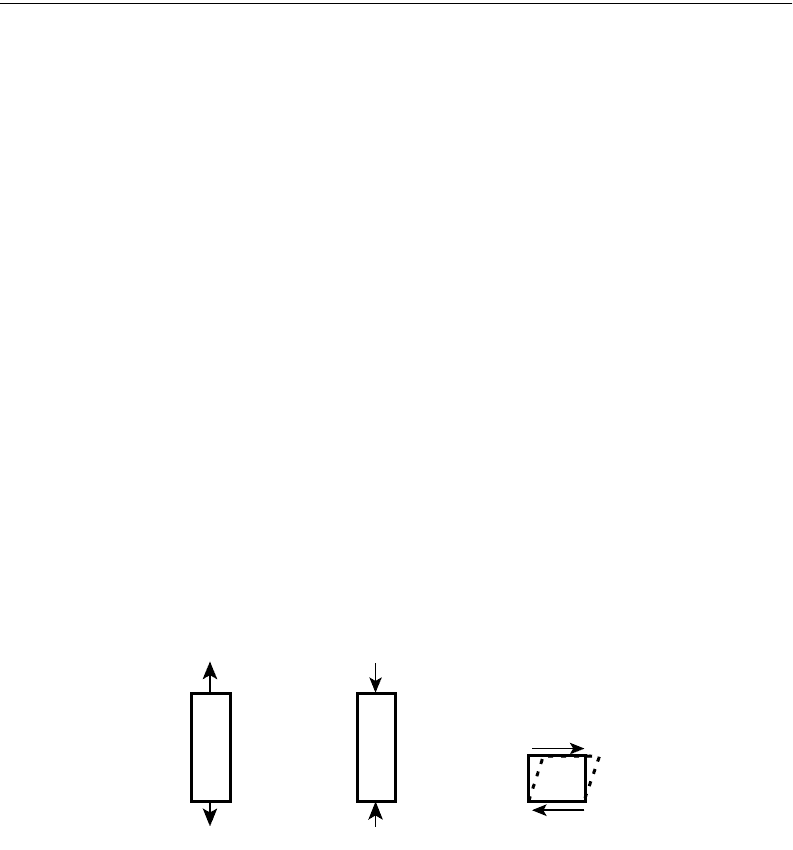
20-34 Mechatronic Systems, Sensors, and Actuators
6. Lawrance, A., Modern Inertial Technology-Navigation, Guidance, and Control, Springer-Verlag: New
York, 1993.
7. McConnell, K. G., Vibration Testing: Theory and Practice, New York: Wiley, 1995.
8. Machine Vibration: Dynamics and Control, London: Springler, 1992–1996.
9. Measuring Vibration, Bruel & Kjaer, 1982.
10. Sydenham, P. H., Hancock, N. H., and Thorn, R., Introduction to Measurement Science and Engi-
neering, New York: Wiley, 1989.
11. Tompkins, W. J. and Webster, J. G., Interfacing Sensors to the IBM PC, Englewood Cliffs, NJ: Prentice-
Hall, 1988.
20.3 Force Measurement
M. A. Elbestawi
Force, which is a vector quantity, can be defined as an action that will cause an acceleration or a certain
reaction of a body. This chapter will outline the methods that can be employed to determine the magnitude
of these forces.
20.3.1 General Considerations
The determination or measurement of forces must yield to the following considerations: if the forces
acting on a body do not produce any acceleration, they must form a system of forces in equilibrium. The
system is then considered to be in static equilibrium. The forces experienced by a body can be classified
into two categories: internal, where the individual particles of a body act on each other, and external
otherwise. If a body is supported by other bodies while subject to the action of forces, deformations
and/or displacements will be produced at the points of support or contact. The internal forces will be
distributed throughout the body until equilibrium is established, and then the body is said to be in a
state of tension, compression, or shear. In considering a body at a definite section, it is evident that all
the internal forces act in pairs, the two forces being equal and opposite, whereas the external forces act
singly.
20.3.2 Hooke’s Law
The basis for force measurement results from the physical behavior of a body under external forces.
Therefore, it is useful to review briefly the mechanical behavior of materials. When a metal is loaded in
uniaxial tension, uniaxial compression, or simple shear (Figure 20.29), it will behave elastically until a critical
value of normal stress (
S
) or shear stress (
τ
) is reached, and then it will deform plastically [1]. In the
FIGURE 20.29 When a metal is loaded in uniaxial tension (a), uniaxial compression (b), or simple shear (c), it
will behave elastically until a critical value of normal stress or shear stress is reached.
p
p
p
F
F
p
(a) (b) (c)
9258_C020.fm Page 34 Tuesday, October 9, 2007 9:08 PM
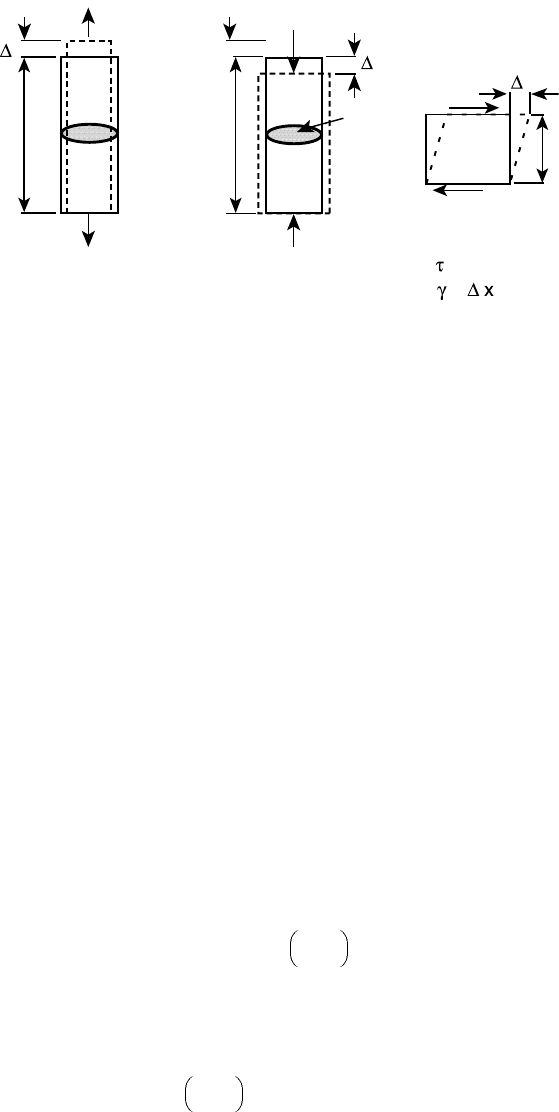
Sensors 20-35
elastic region, the atoms are temporarily displaced but return to their equilibrium positions when the load
is removed. Stress (
S
or
τ
) and strain (
e
or
γ
) in the elastic region are defined as indicated in Figure 20.30.
(20.41)
Poisson’s ratio (v) is the ratio of transverse (e
2
) to direct (e
1
) strain in tension or compression. In the
elastic region, v is between 1/4 and 1/3 for metals. The relation between stress and strain in the elastic
region is given by Hooke’s law:
(20.42)
(20.43)
where E and G are the Young’s and shear modulus of elasticity, respectively. A small change in specific
volume (∆Vol/Vol) can be related to the elastic deformation, which is shown to be as follows for an
isotropic material (same properties in all directions):
(20.44)
The bulk modulus (K = reciprocal of compressibility) is defined as follows:
(20.45)
where ∆p is the pressure acting at a particular point. For an elastic solid loaded in uniaxial compression
(S):
(20.46)
Thus, an elastic solid is compressible as long as
ν
is less than 1/2, which is normally the case for metals.
Hooke’s law, Equation 20.42, for uniaxial tension can be generalized for a three-dimensional elastic condition.
FIGURE 20.30 Elastic stress and strain for: (a) uniaxial tension; (b) uniaxial compression; (c) simple shear [1].
l
o
l
o
A
o
p
t
t
x
p
p
p
F
F
F
y
(a) (b) (c)
S = p /
e =
∆
I / Io e =
∆
I / Io
A
o
S = p /
/
A
o
A
o
/
y
=
=
ν
e
2
e
1
----
–=
SEetension or compression()=
τ
G
γ
simple shear()=
∆Vol
Vol
------------
e
1
12
ν
–()=
K ∆p
/
∆Vol
Vol
------------
=
KS
/
∆Vol
Vol
------------
S
e
1
12
ν
–()
------------------------
E
12
ν
–
---------------
===
9258_C020.fm Page 35 Tuesday, October 9, 2007 9:08 PM
20-36 Mechatronic Systems, Sensors, and Actuators
The theory of elasticity is well established and is used as a basis for force measuring techniques. Note
that the measurement of forces in separate engineering applications is very application specific, and care
must be taken in the selection of the measuring techniques outlined below.
20.3.2.1 Basic Methods of Force Measurement
An unknown force may be measured by the following means:
1. Balancing the unknown force against a standard mass through a system of levers
2. Measuring the acceleration of a known mass
3. Equalizing it to a magnetic force generated by the interaction of a current-carrying coil and a
magnet
4. Distributing the force on a specific area to generate pressure and then measuring the pressure
5. Converting the applied force into the deformation of an elastic element
The aforementioned methods used for measuring forces yield a variety of designs of measuring
equipment. The challenge involved with the task of measuring force resides primarily in sensor design.
The basics of sensor design can be resolved into two problems:
1. Primary geometric, or physical constraints, governed by the application of the force sensor device
2. The means by which the force can be converted into a workable signal form (such as electronic
signals or graduated displacements)
The remaining sections will discuss the types of devices used for force-to-signal conversion and finally
illustrate some examples of applications of these devices for measuring forces.
20.3.3 Force Sensors
Force sensors are required for a basic understanding of the response of a system. For example, cutting
forces generated by a machining process can be monitored to detect a tool failure or to diagnose the
causes of this failure in controlling the process parameters, and in evaluating the quality of the surface
produced. Force sensors are used to monitor impact forces in the automotive industry. Robotic handling
and assembly tasks are controlled by detecting the forces generated at the end effector. Direct measure-
ment of forces is useful in controlling many mechanical systems.
Some types of force sensors are based on measuring a deflection caused by the force. Relatively high
deflections (typically, several micrometers) would be necessary for this technique to be feasible. The
excellent elastic properties of helical springs make it possible to apply them successfully as force sensors
that transform the load to be measured into a deflection. The relation between force and deflection in
the elastic region is demonstrated by Hooke’s law. Force sensors that employ strain gage elements or
piezoelectric (quartz) crystals with built-in microelectronics are common. Both impulsive forces and
slowly varying forces can be monitored using these sensors.
Of the available force measuring techniques, a general subgroup can be defined as that of load cells.
Load cells are comprised generally of a rigid outer structure, some medium that is used for measuring the
applied force, and the measuring gage. Load cells are used for sensing large, static, or slowly varying
forces with little deflection and are a relatively accurate means of sensing forces. Typical accuracies are
of the order of 0.1% of the full-scale readings. Various strategies can be employed for measuring forces
that are strongly dependent on the design of the load cell. For example, Figure 20.31 illustrates different
types of load cells that can be employed in sensing large forces for relatively little cost. The hydraulic
load cell employs a very stiff outer structure with an internal cavity filled with a fluid. Application of a
load increases the oil pressure, which can be read off an accurate gage.
Other sensing techniques can be utilized to monitor forces, such as piezoelectric transducers for quicker
response of varying loads, pneumatic methods, strain gages, etc. The proper sensing technique needs
special consideration based on the conditions required for monitoring.
9258_C020.fm Page 36 Tuesday, October 9, 2007 9:08 PM
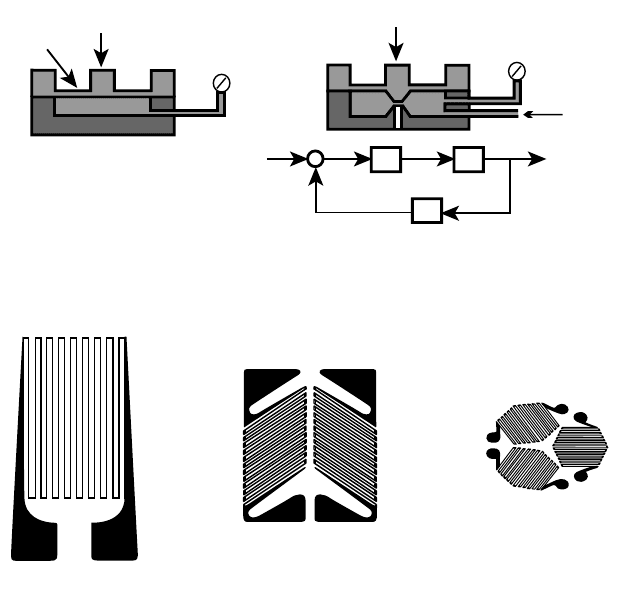
Sensors 20-37
20.3.3.1 Strain Gage Load Cell
The strain gage load cell consists of a structure that elastically deforms when subjected to a force and a
strain gage network that produces an electrical signal proportional to this deformation. Examples of this
are beam and ring types of load cells.
Strain Gages
Strain gages use a length of gage wire to produce the desired resistance (which is usually about 120 Ω)
in the form of a flat coil. This coil is then cemented (bonded) between two thin insulating sheets of paper
or plastic. Such a gage cannot be used directly to measure deflection. It has to be first fixed properly to
a member to be strained. After bonding the gage to the member, they are baked at about 195°F (90°C)
to remove moisture. Coating the unit with wax or resin will provide some mechanical protection. The
resistance between the member under test and the gage itself must be at least 50 MΩ. The total area of
all conductors must remain small so that the cement can easily transmit the force necessary to deform
the wire. As the member is stressed, the resulting strain deforms the strain gage and the cross-sectional
area diminishes. This causes an increase in resistivity of the gage that is easily determined. In order to
measure very small strains, it is necessary to measure small changes of the resistance per unit resistance
(∆R/R). The change in the resistance of a bonded strain gage is usually less than 0.5%. A wide variety
of gage sizes and grid shapes are available, and typical examples are shown in Figure 20.32.
The use of strain gages to measure force requires careful consideration with respect to rigidity and
environment. By virtue of their design, strain gages of shorter length generally possess higher response
frequencies (examples: 660 kHz for a gage of 0.2 mm and 20 kHz for a gage of 60 mm in length). The
environmental considerations focus mainly on the temperature of the gage. It is well known that resis-
tance is a function of temperature and, thus, strain gages are susceptible to variations in temperature.
FIGURE 20.31 Different types of load cells [2].
FIGURE 20.32 Configuration of metal-foil resistance strain gages: (a) single element, (b) two element, and (c) three
element.
Thin diaphragm
Hydraulic load cell
Pneumatic load cell
F
l
F
l
F
l
F
p
K
d
F
net
A
K
a
X
P
o
P
o
P
o
Air supply P
s
(
a
)(
b
)(
c
)
9258_C020.fm Page 37 Tuesday, October 9, 2007 9:08 PM
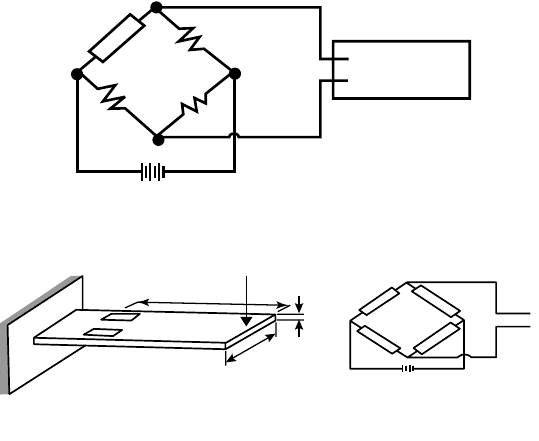
20-38 Mechatronic Systems, Sensors, and Actuators
Thus, if it is known that the temperature of the gage will vary due to any influence, temperature compen-
sation is required in order to ensure that the force measurement is accurate.
A Wheatstone bridge (Figure 20.33) is usually used to measure this small order of magnitude. In
Figure 20.33, no current will flow through the galvanometer (G) if the four resistances satisfy a certain
condition. In order to demonstrate how a Wheatstone bridge operates [3], a voltage scale has been drawn
at points
C
and
D
of Figure 20.33. Assume that
R
1
is a bonded gage and that initially Equation 20.47 is
satisfied. If
R
1
is now stretched so that its resistance increases by one unit (
+∆
R
), the voltage at point
D
will
be increased from zero to plus one unit of voltage (
+∆
V
), and there will be a voltage difference of one unit
between
C
and
D
that will give rise to a current through
C
. If
R
4
is also a bonded gage, and at the same time
that
R
1
changes by
+∆
R
,
R
4
changes by
−∆
R
, the voltage at
D
will move to
+
2
∆
V
. Also, if at the same time,
R
2
changes by
−∆
R
, and
R
3
changes by
+∆
R
, then the voltage of point
C
will move to
−
2
∆
V
, and the voltage
difference between
C
and
D
will now be 4
∆
V
. It is then apparent that although a single gage can be used, the
sensitivity can be increased fourfold if two gages are used in tension while two others are used in compression.
(20.47)
The grid configuration of the metal-foil resistance strain gages is formed by a photo-etching process.
The shortest gage available is 0.20 mm; the longest is 102 mm. Standard gage resistances are 120 Ω and
350 Ω. A strain gage exhibits a resistance change ∆R/R that is related to the strain in the direction of the
grid lines by the expression in Equation 20.48 (where S
g
is the gage factor or calibration constant for the
gage).
(20.48)
Beam-Type Load Cell
Beam-type load cells are commonly employed for measuring low-level loads [3]. A simple cantilever
beam (see Figure 20.34a) with four strain gages, two on the top surface and two on the bottom surface
(all oriented along the axis of the beam) is used as the elastic member (sensor) for the load cell. The gages
FIGURE 20.33 The Wheatstone bridge.
FIGURE 20.34 Beam-type load cells: (a) a selection of beam-type load cells (elastic element with strain gages), and
(b) gage positions in the Wheatstone bridge [3].
R
g
G
C
D
+–
Gage
Voltage recording
device
R
4
R
2
R
3
E
l
E
o
1
4
3
2
To p
To p
Bottom
Bottom
E
l
E
o
+
–
1
3
Axial gages
2 and 4 on the
bottom surface
Axial gages
1 and 3
x
p
b
h
(a) (b)
R
1
R
4
-----
R
2
R
3
-----
=
∆R
R
-------
S
g
ε
=
9258_C020.fm Page 38 Tuesday, October 9, 2007 9:08 PM
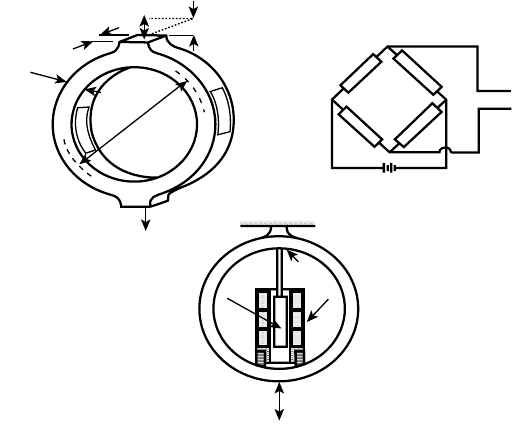
Sensors 20-39
are wired into a Wheatstone bridge as shown in Figure 20.34b. The load P produces a moment M = Px
at the gage location (x) that results in the following strains:
(20.49)
where b is the width of the cross-section of the beam and h is the height of the cross-section of the beam.
Thus, the response of the strain gages is obtained from Equation 20.50.
(20.50)
The output voltage
E
o
from the Wheatstone bridge, resulting from application of the load
P
, is obtained from
Equation 20.51. If the four strain gages on the beam are assumed to be identical, then Equation 20.51 holds.
(20.51)
The range and sensitivity of a beam-type load cell depends on the shape of the cross-section of the beam,
the location of the point of application of the load, and the fatigue strength of the material from which
the beam is fabricated.
Ring-Type Load Cell
Ring-type load cells incorporate a proving ring (see Figure 20.35) as the elastic element. The ring element
can be designed to cover a very wide range of loads by varying the diameter D, the thickness t, or the
depth w of the ring. Either strain gages or a linear variable-differential transformer (LVDT) can be used
as the sensor.
FIGURE 20.35 Ring-type load cells: (a) elastic element with strain-gage sensors; (b) gage positions in the Wheat-
stone bridge; and (c) elastic element with an LVDT sensor [3].
ε
1
ε
2
–
ε
3
ε
4
–
6M
Ebh
2
-----------
6Px
Ebh
2
-----------
==== =
∆R
1
R
1
---------
∆R
2
R
2
---------
∆R
3
R
3
---------
∆R
4
R
4
---------
6S
g
Px
Ebh
2
--------------
=–==–=
E
o
6S
g
PxE
1
Ebh
2
--------------------
=
Gage 2
outside
Gage 3
inside
t
w
p
δ
4
1
p
D = 2R
p
(c)
(b)
(a)
Core
Proving
ring
LVDT
+
4
3
2
1
–
Top
Top
Bottom
Bottom
E
1
E
0
9258_C020.fm Page 39 Tuesday, October 9, 2007 9:08 PM
20-40 Mechatronic Systems, Sensors, and Actuators
The load P is linearly proportional to the output voltage E
o
. The sensitivity of the ring-type load cell
with an LVDT sensor depends on the geometry of the ring (R, t, and w), the material from which the
ring is fabricated (E), and the characteristics of the LVDT (S and E
i
). The range of a ring-type load cell
is controlled by the strength of the material used in fabricating the ring.
20.3.3.2 Piezoelectric Methods
A piezoelectric material exhibits a phenomenon known as the piezoelectric effect. This effect states that
when asymmetrical, elastic crystals are deformed by a force, an electrical potential will be developed
within the distorted crystal lattice. This effect is reversible. That is, if a potential is applied between the
surfaces of the crystal, it will change its physical dimensions [4]. Elements exhibiting piezoelectric qualities
are sometimes known as electrorestrictive elements.
The magnitude and polarity of the induced surface charges are proportional to the magnitude and
direction of the applied force [4]:
(20.52)
where d is the charge sensitivity (a constant for a given crystal) of the crystal in C/N. The force F causes
a thickness variation ∆t meters of the crystal:
(20.53)
where a is area of crystal, t is thickness of crystal, and Y is Young’s modulus.
(20.54)
The charge at the electrodes gives rise to a voltage E
o
= Q/C, where C is capacitance in farads between
the electrodes and C =
ε
a/t where
ε
is the absolute permittivity.
(20.55)
The voltage sensitivity = g = d/
ε
in volt meter per newton can be obtained as:
(20.56)
The piezoelectric materials used are quartz, tourmaline, Rochelle salt, ammonium dihydrogen phosphate
(ADP), lithium sulfate, barium titanate, and lead zirconate titanate (PZT) [4]. Quartz and other earthly
piezoelectric crystals are naturally polarized. However, synthetic piezoelectric material, such as barium
titanate ceramic, are made by baking small crystallites under pressure and then placing the resultant
material in a strong dc electric field [4]. After that, the crystal is polarized, along the axis on which the
force will be applied, to exhibit piezoelectric properties. Artificial piezoelectric elements are free from
the limitations imposed by the crystal structure and can be molded into any size and shape. The direction
of polarization is designated during their production process.
The different modes of operation of a piezoelectric device for a simple plate are shown in Figure 20.36
[4]. By adhering two crystals together so that their electrical axes are perpendicular, bending moments
or torque can be applied to the piezoelectric transducer and a voltage output can be produced
(Figure 20.37) [4]. The range of forces that can be measured using piezoelectric transducers are from
1 to 200 kN and at a ratio of 2 × 10
5
.
Piezoelectric crystals can also be used in measuring an instantaneous change in the force (dynamic
forces). A thin plate of quartz can be used as an electronic oscillator. The frequency of these oscillations
will be dominated by the natural frequency of the thin plate. Any distortion in the shape of the plate
QdF=
F
aY
t
------
∆t=
Y
stress
strain
-------------
Ft
a∆t
---------
==
E
o
dF
C
------
d
ε
--
tF
a
-----
==
E
o
g
t
a
--
FgtP==
9258_C020.fm Page 40 Tuesday, October 9, 2007 9:08 PM
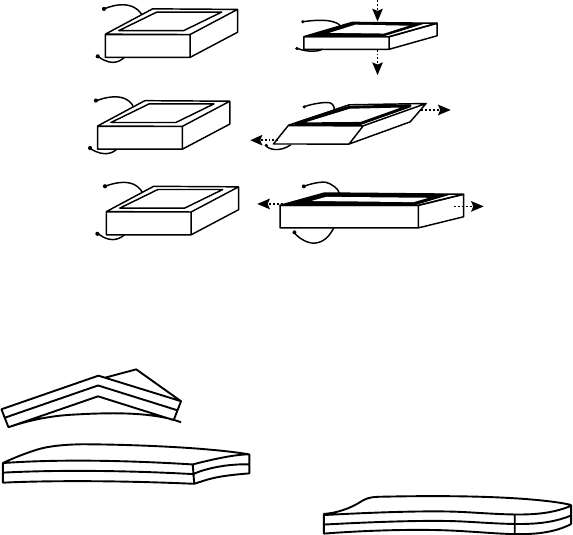
Sensors 20-41
caused by an external force, alters the oscillation frequency. Hence, a dynamic force can be measured by
the change in frequency of the oscillator.
Resistive Method
The resistive method employs the fact that when the multiple contact area between semiconducting
particles (usually carbon) and the distance between the particles are changed, the total resistance is altered.
The design of such transducers yields a very small displacement when a force is applied. A transducer
might consist of 2–60 thin carbon disks mounted between a fixed and a movable electrode. When a force
is applied to the movable electrode and the carbon disks move together by 5–250
µ
m per interface, the
transfer function of their resistance against the applied force is approximately hyperbolic, that is, highly
nonlinear. The device is also subject to large hysteresis and drift together with a high transverse sensitivity.
In order to reduce hysteresis and drift, rings are used instead of disks. The rings are mounted on an
insulated rigid core and prestressed. This almost completely eliminates any transverse sensitivity error.
The core’s resonant frequency is high and can occur at a frequency as high as 10 kHz. The possible
measuring range of such a transducer is from 0.1 to 10 kg. The accuracy and linear sensitivity of this
transducer is very poor.
Inductive Method
The inductive method utilizes the fact that a change in mechanical stress of a ferromagnetic material
causes its permeability to alter. The changes in magnetic flux are converted into induced voltages in the
pickup coils as the movement takes place. This phenomenon is known as the Villari effect or magneto-
striction. It is known to be particularly strong in nickel–iron alloys.
Transducers utilizing the Villari effect consist of a coil wound on a core of magnetostrictive material.
The force to be measured is applied on this core, stressing it and causing a change in its permeability
and inductance. This change can be monitored and used for determining the force.
FIGURE 20.36 Modes of operation for a simple plate as a piezoelectric device [4].
FIGURE 20.37 Curvature of “twister” and “bender” piezoelectric transducers when voltage applied [4].
+
+
+
–
–
–
(a)
(b)
(c)
Crystal twister ''bimorph''
Crystal bender ''bimorph''
Ceramic bender ''bimorph''
or ''multimorph''
9258_C020.fm Page 41 Tuesday, October 9, 2007 9:08 PM

20-42 Mechatronic Systems, Sensors, and Actuators
The applicable range for this type of transducer is a function of the cross-sectional area of the core.
The accuracy of the device is determined by a calibration process. This transducer has poor linearity and
is subject to hysteresis. The permeability of a magnetostrictive material increases when it is subject to
pure torsion, regardless of direction. A flat frequency response is obtained over a wide range from 150
to 15,000 Hz.
Piezotransistor Method
Devices that utilize anisotropic stress effects are described as piezotransistors. In this effect, if the upper
surface of a p-n diode is subjected to a localized stress, a significant reversible change occurs in the current
across the junction. These transistors are usually silicon nonplanar type, with an emitter base junction.
This junction is mechanically connected to a diaphragm positioned on the upper surface of a typical
TO-type can [4]. When a pressure or a force is applied to the diaphragm, an electronic charge is produced.
It is advisable to use these force-measuring devices at a constant temperature by virtue of the fact that
semiconducting materials also change their electric properties with temperature variations. The attractive
characteristic of piezotransistors is that they can withstand a 500% overload.
Multicomponent Dynamometers Using Quartz Crystals as Sensing Elements
The Piezoelectric Effects in Quartz
For force measurements, the direct piezoelectric effect is utilized. The direct longitudinal effect measures
compressive force; the direct shear effect measures shear force in one direction. For example, if a disk of
crystalline quartz (SiO
2
) cut normally to the crystallographic x-axis is loaded by a compression force, it
will yield an electric charge, nominally 2.26 pC/N. If a disk of crystalline quartz is cut normally to the
crystallographic y-axis, it will yield an electric charge (4.52 pC/N) if loaded by a shear force in one specific
direction. Forces applied in the other directions will not generate any output [5].
A charge amplifier is used to convert the charge yielded by a quartz crystal element into a propor-
tional voltage. The range of a charge amplifier with respect to its conversion factor is determined by
a feedback capacitor. Adjustment to mechanical units is obtained by additional operational amplifiers
with variable gain.
The Design of Quartz Multicomponent Dynamometers
The main element for designing multicomponent dynamometers is the three-component force transducer
(Figure 20.38). It contains a pair of X-cut quartz disks for the normal force component and a pair of
Y-cut quartz disks (shear-sensitive) for each shear force component.
Three-component dynamometers can be used for measuring cutting forces during machining. Four
three-component force transducers sandwiched between a base plate and a top plate are shown in
Figure 20.38. The force transducer is subjected to a preload as shear forces are transmitted by friction.
The four force transducers experience a drastic change in their load, depending on the type and position
of force application. An overhanging introduction of the force develops a tensile force for some trans-
ducers, thus reducing the preload. Bending of the dynamometer top plate causes bending and shearing
stresses. The measuring ranges of a dynamometer depend not only on the individual forces, but also on
the individul bending stresses.
FIGURE 20.38 Three-component force transducer.
+
–
+
–
+
–
+
–
+
–
+
–
+
–
+
–
+
–
+
–
+
–
+
–
+
–
+
–
+
–
+
–
+
–
+
–
+
–
+
–
+
–
+
–
+
–
+
–
+
–
+
–
+
–
+
–
+
–
+
–
2
3
4
1
X
Z
Y
v
9258_C020.fm Page 42 Tuesday, October 9, 2007 9:08 PM
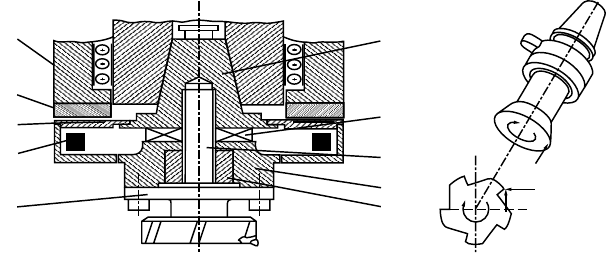
Sensors 20-43
Measuring Signals Transmitted by Telemetry
Figure 20.39 shows the newly designed force measuring system RCD (rotating cutting force dynamom-
eter). A ring-shaped sensor (1) is fitted in a steep angle taper socket (2) and a base ring (3) allowing
sensing of the three force components F
x
, F
y
, and F
z
at the cutting edge as well as the moment M
z
. The
physical operating principle of this measuring cell is based on the piezoelectric effect in quartz plates.
The quartz plates incorporated in the sensor are aligned so that the maximum cross-sensitivity between
the force components is 1%. As a result of the rigid design of the sensor, the resonant frequencies of the
force measuring system range from 1200 to 3000 Hz and the measuring ranges cover a maximum of
10 kN [6].
Force-proportional charges produced at the surfaces of the quartz plates are converted into voltages
by four miniature charge amplifiers (7) in hybrid construction. These signals are then filtered by specific
electrical circuitry to prevent aliasing effects, and digitized with 8-bit resolution using a high sampling
rate (pulse-code modulation). The digitized signals are transmitted by a telemetric unit consisting of a
receiver and transmitter module, an antenna at the top of the rotating force measuring system (8), as
well as a fixed antenna (9) on the splash cover of the two-axis milling head (10). The electrical compo-
nents, charge amplifier, and transmitter module are mounted on the circumference of the force measuring
system [6].
The cutting forces and the moment measured are digitized with the force measuring system described
above. They are modulated on an FM carrier and transmitted by the rotating transmitter to the stationary
receiver. The signals transmitted are fed to an external measured-variable conditioning unit.
Measuring Dynamic Forces
Any mechanical system can be considered in the first approximation as a weakly damped oscillator
consisting of a spring and a mass. If a mechanical system has more than one resonant frequency, the
lowest one must be taken into consideration. As long as the test frequency remains below 10% of the
resonant frequency of the reference transducer (used for calibration), the difference between the dynamic
sensitivity obtained from static calibration will be less than 1%. The above considerations assume a
sinusoidal force signal. The static calibration of a reference transducer is also valid for dynamic calibration
purposes if the test frequency is much lower (at least 10 times lower) than the resonant frequency of the
system.
20.3.3.3 Capacitive Force Transducer
A transducer that uses capacitance variation can be used to measure force. The force is directed onto a
membrane whose elastic deflection is detected by a capacitance variation. A highly sensitive force trans-
ducer can be constructed because the capacitive transducer senses very small deflections accurately. An
electronic circuit converts the capacitance variations into DC-voltage variations [7].
FIGURE 20.39 Force measuring system to determine the tool-related cutting forces in five-axis milling [6].
2
1
4
3
5
10
9
8
7
6
Mz
Fz
Fx
Fy
Mz
9258_C020.fm Page 43 Tuesday, October 9, 2007 9:08 PM
